Related Content
Content
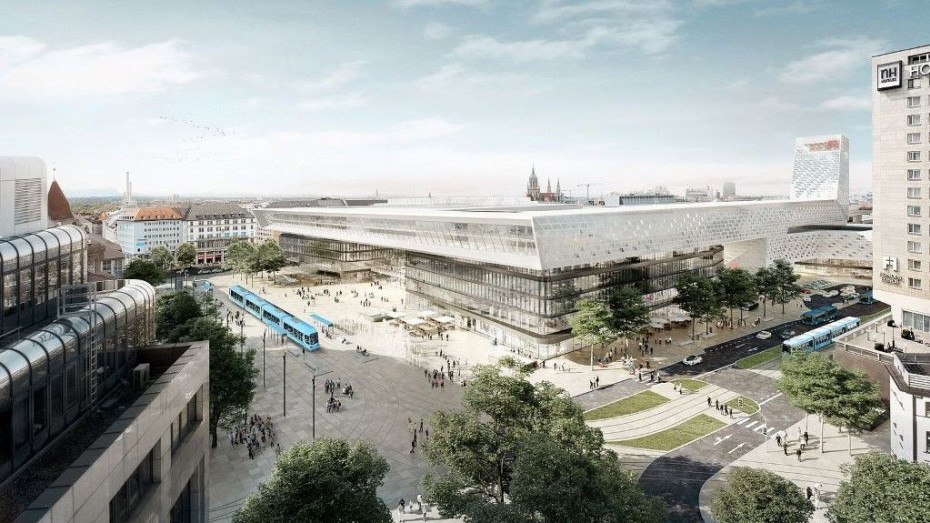
Share
The completion of the huge Koralmbahn project in Austria and its upcoming opening to passenger train services is a major milestone for European rail travel.
It is the latest development in a chain of transformative rail construction projects, which will continue over the next 15 years and beyond.
It's prompted thoughts that an overview of these projects, which have already been commenced or will definitely be proceeding would be useful - Both to provide a quick guide to the future traveller benefits and also to explain why the use of existing routes and stations will, at times, be compromised.
In use by 2030
You'll see that what has been deliberately avoided below are the completion dates of these projects, two reasons for this:
(1) There always has to be a gap between the construction work being completed and the passenger train service actually commencing, and
(2) Getting the trains into service can have unexpected complications, so predicting precise opening dates can be a fool's errand.
So instead the projects have been arranged into a fairly loose order, with what's most likely to open first at the top.
Budapest ↔ Beograd / Belgrade
This project is the now completed construction of a higher speed rail route between the Hungarian and Serbian capitals.
Definite Benefits
A direct rail service between Budapest and Beograd/Belgrade via Novi Sad will be restored with a projected travel time of 4.5 hours, almost halving the time of the prior service which had to be withdrawn more than eight years ago to enable the construction to occur.
The new service will be the most frequent ever rail service provided between Budapest and Beograd / Belgrade.
Likely Benefits
This is a tad to be confirmed, but the direct Zagreb ↔ Beograd/Belgrade regular trains were withdrawn a few years ago with construction works citied as the reason, and these trains would use the southern section of the new line - hence could they also resume?
Wish List Benefits
(1) Direct daytime trains could link Wien/Vienna with Beograd/Belgrade in a travel time of less than 8 hours.
(2) Ultimately the line could be used by trains taking a Budapest ↔ Sofia route.
Brescia ↔ Verona
The next stage of what will be a Milano ↔ Venezia / Venice high speed line, should open between Brescia and Verona in 2026.
The journey time between Milano Centrale and Verona will come down to around 1 hour - and the Milano to Venezia time will be reduced to around 2hr 10mins.
Though the new line will bypass both Desenzano del Garda and Peschiera del Garda and most of the current express services between Milano and Venezia call at either one of these stations.
By 2028 the next section of the route Verona and Vicenza should also be in use.
Definite Benefits
The end-to end journey time between Milano and Venezia/Venice will then come down to around 1hr 45mins, which is 40 mins faster than the current timings
Likely Benefits
Despite the multiple cities that the Milano ↔ Venezia/Venice route serves, the current timetable isn't regular, as there can be gaps of 90mins between departures.
So the enhanced capacity should enable a minimum of 2 x trains per hour travelling Milan - Brescia - Verona - Vicenza - Padova - Venezia.
There will also probably more services than currently on these routes:
- Genova ↔ Venezia
- Torino ↔ Venezia
- Milano ↔ Bolzano
- Milano ↔ Trieste
Wish List Benefits
Will there perhaps be direct Frecce trains between Paris and the new line? Thereby re-introducing direct trains between the French capital and Venezia.
Amsterdam Centraal station
The second phase of the transformation of the Dutch capital's premier station has begun.
Definite Benefits
Easier access to and from the trains, particularly for those who find using stairs difficult or impossible.
Likely Benefits
The number of available platforms is currently constricted, so the higher speed domestic ICD services operated by NS on the Amsterdam ↔ Rotterdam high speed line, have been switched to use Amsterdam Zuid, see below.
Though once the work has been completed, its likely that will be restored to Amsterdam-Centraal.
Wish List Benefits
Multiple cities and large towns in eastern Netherlands including Groningen Leeuwarden, and Zwolle currently lack direct trains to/from Amsterdam Centraal, so these and other routes could potentially take advantage of the redeveloped station's enhanced capacity.
Stuttgart ↔ Ulm
This project combines the opening the full length of the Stuttgart ↔ Ulm high-speed line and the utterly transformed Stuttgart Hbf - the city's main rail station.
Definite Benefits
- Trains which take the Cologne / Frankfurt / Karlsruhe - Stuttgart ↔ Ulm - Augsburg - Munich routes will no longer have to reverse direction in and out of Stuttgart - and this combined with the opening of the full length of the high-speed route, will reduce end-to-end journey times by 30 to 40 minutes.
- This reduction in journey times will therefore also benefit journeys between both Ulm and Augsburg and a swathe of other cities including Dusseldorf, Leipzig and Hamburg.
- The rail journey time for Stuttgart ↔ Munich will come down to 1hr 30mins.
Likely Benefits
It is likely that an enhanced service will also be available on two routes which connect Germany with Austria:
- Frankfurt (Main) - Mannheim - Stuttgart ↔ Ulm - Augsburg - Munich - Salzburg - Villach - Klagenfurt - Graz
- Frankfurt (Main) / Karlsruhe - Stuttgart ↔ Ulm - Augsburg - Munich - Salzburg - Linz - Vienna
Wish List Benefits
Only one train per day links currently links Paris with Munich / Munchen, but four other services operate Paris ↔ Stuttgart, so it would make sense of more of these services had their journeys extended to/from Munich / Munchen.
Also there is currently only one train per day which takes a Basel - Karlsruhe - Stuttgart ↔ Ulm - Augsburg - Munich route, so an increased level of service on this route would be a logical and welcome benefit.
AVE station at Barajas Airport
The guide to airport rail connections will ultimately need to be updated, as a station dedicated to high speed train services will be opening at Madrid-Barajas Airport.
The new station is close to completion, so presumably from as soon as 2026, some of the trains between Madrid and both Alicante and Valencia will have their journeys extended to serve Madrid-Barajas.
Particularly because most of these trains are currently being turned around at Madrid Chamartin, so the journey to and from Barajas will be a short extension of their current routes.
Trains between Madrid-Barajas and both Malaga and Sevilla will presumably be hold until the redevelopment of Atocha station is fully opened - see below.
Paris Austerlitz
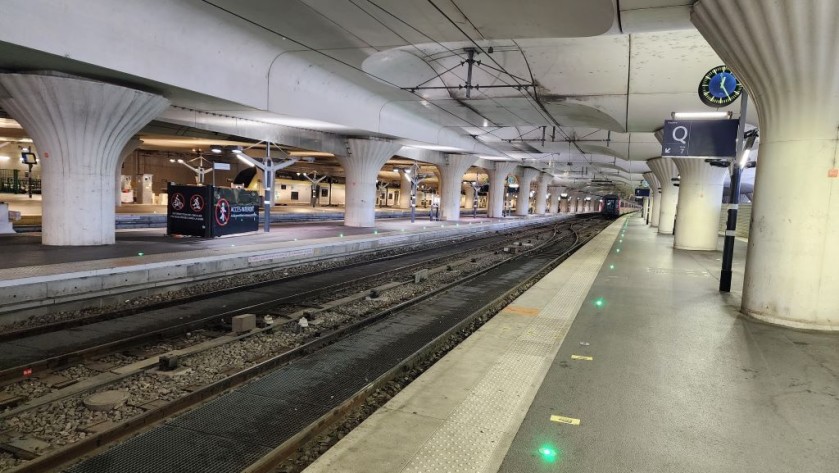
Following enhancement projects at Gare Du Nord, Gare de l'Est, Gare Montparnasse and the Gare De Lyon, the Gare Austerlitz is to be the next Paris rail terminal that will be enhanced.
However, at Austerlitz the work involves an expansion which goes beyond a renovation.
The project includes doubling the number of platforms and re-opening parts of the station that have been shut off for decades.
Definite Benefits
Travellers using Paris Austerlitz will be be able to use more shops, eating areas and waiting rooms. plus the transfers to and from both the metro and RER line C will be transformed with the provision of step-free options
Likely Benefit
The increase in the number of platforms could enable some of the high-speed trains which currently use both the Gare De Lyon and Montparnasse to be switched to Austerlitz, thereby relieving the capacity at both the other Paris terminals and their connecting high speed lines.
If this does happen it opens up the possibility for Austerlitz to become the dedicated Paris terminal for Ouigo services between the French capital and destinations to the south.
Genoa ↔ Milan / Turin
The core aim of this project is to provide an easier route for freight trains that need to access the ports in Genova and Livorno.
Definite Benefits
Though the line, which is more than 50kms in length, will have a maximum speed of 250 km/h so it meets the high-speed line criteria.
Therefore the journey time of trains travelling between Milano and Genova will come down by 20-25 mins and that between Torino/Turin and Genova will be reduced by 15 mins.
Likely Benefits
The new line will also increase capacity so it's likely that the number of trains between Genova and both Milano and Torino will be increased.
This route in combination with the new line between Brescia and Verona, will enable a Genova ↔ Venezia / Venice journey time of around 3hr 10mins, so a minimum of a couple of direct Frecce trains per day should be available.
Wish-List Benefits
Could some of these Venice ↔ Genova trains have their journeys extended to and from Pisa?
If that did happen Venice, Padua, Vicenza and Verona would also have direct rail links with Sestri Levante, the Cinque Terra and La Spezia.
Fredericia ↔ Aalborg
This project will enable electric trains to operate along the full length of the Copenhagen - Odense - Aarhus - Aalborg route, which connects the four largest cities in Denmark.
New trains similar to the latest Dutch trains will operate the services and Aarhus H station is also being redeveloped.
Definite Benefits
Two fast trains per hour will operate along the length of the route and journey times will be significantly reduced, Copenhagen ↔ Aalborg will come down from 4.5 hours to 3 hours and Copenhagen ↔ Aarhus will be reduced to only 2 hours.
Likely Benefit
The work on both the route and Aarhus station were cited as reasons for the withdrawal of the long-standing Hamburg ↔ Aarhus service a few years ago, so hopefully it will be restored.
Lyon Part-Dieu
Despite becoming the city's primary rail station less than 45 years ago, Lyon Part-Dieu had evolved into a confusing and overcrowded connection hub between train, tram and metro services.
Hence it is being completely rebuilt in order to provide more space and easier access to/from the trains
Because the platforms are above street level the dominant feature of the original station were its staircases.
Though the number of platforms won't be increased, so the project's core benefit will be the improvements in the passenger flow in and around the station.
Naples ↔ Bari
This high-speed line will span central Italy between the Mediterranean and the Adriatic.
Definite Benefits
The project will deliver multiple benefits to travellers:
- The Rome ↔ Bari journey time will come down by more than an hour to 3 hours
- There are currently no direct trains between Napoli/Naples and Bari, but when the line opens, new services will link the two cities in only two hours
- Cities beyond the line will also benefit, as many of the trains to/from Bari will travel on to/from Lecce, so Florence/Firenze ↔ Bari - Lecce journeys will also be an hour faster - and will also likely be more frequent.
Ljubljana
This route through The Balkans and on to Sofia and Greece had been going backwards in recent years
The direct trains have been suspended on these routes:
- Ljubljana - Zagreb ↔ Beograd/Belgrade
- Beograd/Belgrade ↔ Sofia
- Sofia ↔ Thessaloniki
- Frankfurt - Munchen - Salzburg - Villach ↔ Ljubljana - Zagreb (resumes on Dec 14th 2025)
However, there is a published strategy to improve the strategic Trieste - Ljubljana - Zagreb - Belgrade rail route.
In Ljubljana it meets the route to and from Villach in Austria - which connects Ljubljana and Zagreb by train to Salzburg, Zurich and Munich.
A sign that a corner has been turned towards a brighter future is the ongoing transformation of Ljubljana station.
Cross Madrid AVE trains at Madrid Chamartin
The Madrid Interconnector is a cross-city rail tunnel in Madrid dedicated to high speed trains.
It has already opened, as most of the trains between both Alicante and Valencia are using it to travel to and from Madrid-Charmartin.
These trains would have previously been terminated at Madrid-Atocha, but they have been re-routed, as work is ongoing to connect the tunnel to Atocha station.
This project also requires new below ground platforms for the AVE trains at Atocha station, plus an additional entrance hall on the western side of Madrid-Atocha.
Definite Benefits
(1) The AVE trains on these existing routes can also call at Atocha:
- Valladolid - Madrid Chamartin - Alicante
- Leon - Madrid Chamartin - Valencia
- Burgos - Madrid Chamartin - Murcia
- Gijon - Valladolid Madrid Chamartin - Valencia - Castello
- Santander- Madrid Chamartin - Alicante
It's likely that both Alicante and Valencia will also be connected to additional destinations in northern Spain.
(2) Cordoba, Granada, Malaga and Sevilla will be linked to multiple destinations in northern Spain. including Burgos, Leon and Gijon, by direct AVE trains, which will call at both Atocha and Chamartin stations in Madrid.
(3) Alicante Cordoba, Malaga, Sevilla and Valencia will have direct trains to and from Madrid-Barajas Airport, which will call at both Atocha and Chamartin stations in Madrid.
(4) There will be an additional departure hall for the high-speed trains in Atocha, which will ease how busy the current main departure hall can be.
Gent St Pieters
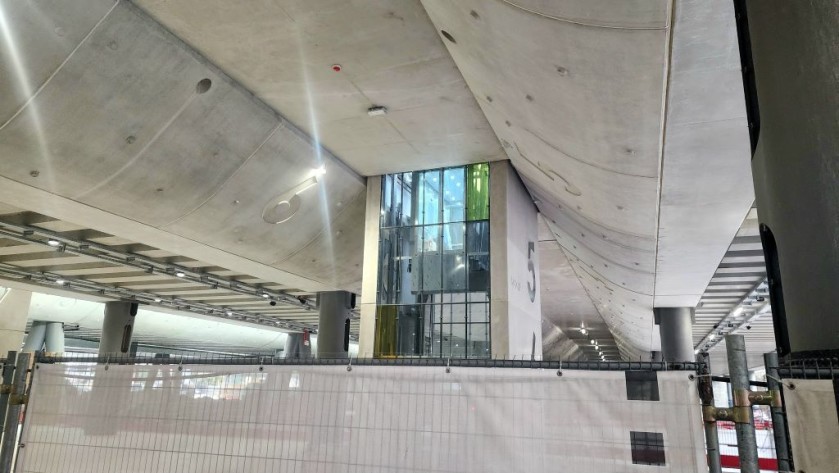
I was at Gent St Pieters station in 2018 and took a train from an almost completed new platform 11 and 12, and observed that work was well underway on platforms 9 and 10.
Hence on a recent visit I was surprised to see the lack of progress, with demolition work very evident on platforms 1 to 4 and with only platforms 6 to 12 in use.
Indicators of how difficult and slow it can be to rebuild a station while maintaining its usual train service.
Ultimately the station will be transformed with step-free access by lift and escalator to all platforms, from both an expanded central passage way and a wholly new passage under the platforms at the western end.
With the huge space between them, under the platforms, housing expanded facilities.
The Trans-Pennine Route Upgrade
This project will transform the Manchester - Huddersfield - Leeds - York rail route, which between Manchester and Leeds has to handle one of the most intensive city to city train services in Europe.
The [**key benefits]((https://thetrupgrade.co.uk/benefits/) of the the Trans-Pennine Route Upgrade will be:
- a fully electrified Manchester - Leeds - York route
- a 9 mile dedicated two track route for express trains between Huddersfield and Dewsbury, to be used by the four trains per hour which travel along the Manchester - Huddersfield - Leeds 'corridor'
- Journey times between Manchester and York to be more than 10 mins faster
- Huddersfield station to be upgraded and expanded
- Multiple other stations to have better mobility access
Semmering Base Tunnel
The opening of the Koralmbahn route between Graz and Klagenfurt is merely the first stage of the transformation of rail services in eastern Austria.
The Semmering Railway is beautiful, but it twists and turns on either side of the mountain pass so speeds are slow.
Hence the 27.3 km long Semmering Base Tunnel will be transformative, as it shortens the existing route by more than 12km and the speed of the train in the tunnel will be more than 200km/h.
Definite Benefits
Journey times will be reduced by 25 minutes, so once trains can use it, the timings to and from Vienna/Wien will be:
- Graz = 2hr 10mins
- Klagenfurt = 3 hours; the current timing is 3hr 55min
- Villach = 3hr 25mins
- Bad Gastein = 4hr 25mins
- Ljubljana = 5hr 20mins
- Venice = 6hr 45mins
Amsterdam Zuid
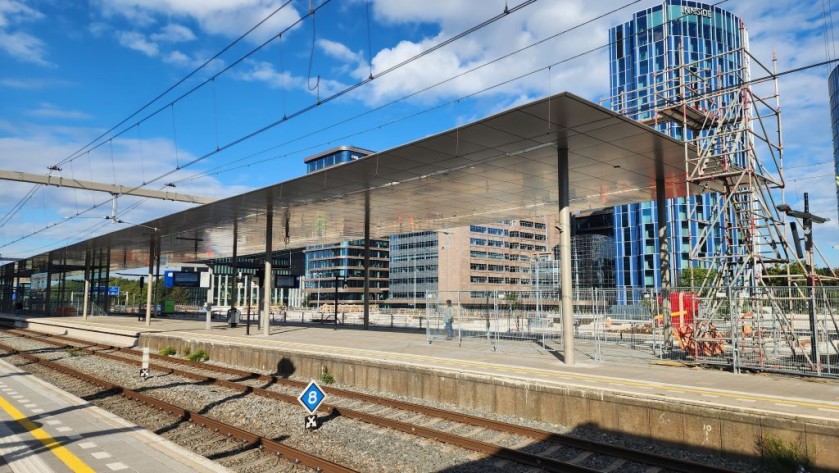
Trains between multiple Dutch cities take two routes to/from the Dutch capital, one calls at Amsterdam Centraal (see above) and the other calls at Amsterdam Zuid and Schiphol Airport.
Also trains between Amsterdam and Groningen, Leeuwarden and Zwolle only take the route to and from Amsterdam Zuid and Schiphol.
Hence 24 IC express trains per hour currently call at Amsterdam Zuid compared to only 16 at Amsterdam Centraal,
Amsterdam Zuid is also now served by three lines of the Amsterdam Metro including the north-south line 52 which crosses the heart of the city.
As a consequence the station is being transformed and expanded to make it easier to transfer between the trains, metro and trams - thereby enhancing its role as the public transport hub for the southern side of Amsterdam city centre.
Firenze Belfiore
Firenze S.M.Novella station has a fantastic location in the heart of Florence, but as it is a terminus station, it creates problems for the Italian rail timetable.
Because the Frecce and Italo trains which use the Torino - Milano - Bologna - Firenze/Florence - Roma - Napoli - Salerno high speed line have to divert off the direct route in order to call at Firenze S.M.Novella, where they reverse in and out of the station.
The complexities of the railways in and around Firenze/Florence has also forced a gap in that north <> south high speed route, between a Milano ↔ Firenze/Florence line and a Firenze/Florence ↔ Roma line.
Therefore the existing non-stop Milano ↔ Roma trains have to spend 10 mins travelling at only 50 to 70 km/h as they thread a path around the Regionale trains from and to Firenze.
Hence that gap between the two high speed lines is to be closed and along the new link there will be Firenze Belfiore station.
Definite Benefits
- A doubling of the number trains taking the Milano ↔ Roma route which call in Firenze/Florence.
- Trains which call in Firenze/Florence while travelling between Milano and Roma, will have their end-to-end journey times reduced by around 20 mins.
- The Frecce and Italo trains on the Venezia/Venice ↔ Rome route will also have their journey times reduced by 20 minutes, as virtually all of these trains currently call at Firenze S.M.Novella.
- Non-stop trains travelling between Milano and Roma will have their journey times reduced by 10 minutes.
- The introduction of non-stop trains between Milano and Firenze/Florence.
Likely Benefits
It would make sense for Firenze to gain daytime international rail connections, as currently the only international rail links which serve the city are the Nightjet trains to and from both Munich and Vienna.
A future Munich - Innsbruck - Firenze - Roma daytime express has already been confirmed, but it would be logical for both some Paris ↔ Milano Frecce trains to have their routes extended to Firenze/Florence.
Wish List Benefits
The removal of close to all of the Frecce and Italo trains from Firenze S.M.Novella will provide the capacity for the station to become a hub for InterCity services.
They also won't get in the way of the high-speed trains, so it creates the scope for:
- more trains on the Firenze - Prato - Bologna - Modena - Parma - Piacenza - Milano route
- a new Firenze - La Spezia - Genova - Sanremo - Ventimiglia (connect for Nice) route by IC trains.
- a new Firenze - Pisa - Livorno - Grosetto - Roma route by IC trains.
Valencia Central station
The high speed lines in Spain have a different track gauge to the older 'classic' railways, hence a new station in Valencia was put together when the AVE trains began to serve the city, but it was always intended to be a temporary structure.
It's connections with both the older city centre station and the Metro are indirect and compromised.
Hence the creation of Valencia Central station which will be used by all of the train services to and from the city, plus it will also be a major public transport hub.
Valencia Joaquin-Sorolla station will in effect be replaced, but the beautiful Valencia Nord station buildings will be retained, to become the access route between the new Central station and the city centre.
A new station in Hamburg
All of the express trains between Hamburg and locations to the south call at the city's main station, Hamburg Hbf, but to the north of Hamburg Hbf they have to take one of two routes:
- To and from Hamburg-Altona, which is a terminus station, and is showing its age as it was constructed back in the 1960s;
- Travelling to/from destinations to the north of Hamburg including Denmark, Flensburg, Kiel and Westerland.
Hence the decision to replace the current Hamburg-Altona station, with an entirely new station, Hamburg-Altona-Nord. which will be located on that route which links Hamburg to northern Germany and Denmark.
The Altona area of Hamburg will therefore be linked to more destinations and this area of the city will have a core rail hub.
The express trains to/from locations to the south of the city can be consolidated, as they will terminate at the new station, or call there on route to/from locations including Kiel.
Local S-Bahn trains will link the new station with the location of the current Hamburg-Altona station.
The Basque Y
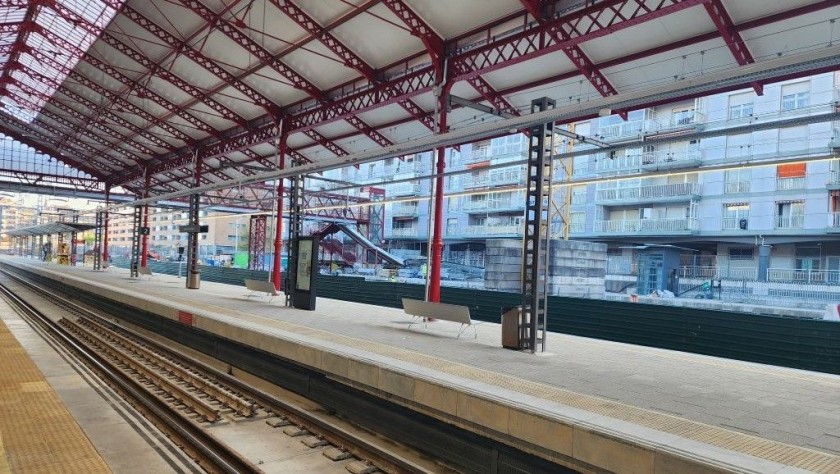
The Basque Y is to be a high speed route between between Burgos and Vitoria where it will split into routes, one of which will serve Bilbao and the other will serve San Sebastian and Irun (connect for Hendaye in France).
A link at the junction will also enable Bilbao ↔ San Sebastian - Hendaye services.
Though questions hover over the already much delayed project.
Construction work which will expand San Sebastian station has begun, but local news reporting suggests that work is still to commence on other key parts of the project including the junction which will link the routes.
Definite Benefits
- AVE trains will be used on the Madrid ↔ Bilbao and Madrid ↔ San Sebastian - Hendaye routes with end-to-end journey times reduced by more than an hour.
- The national rail operator Renfe doesn't operate Bilbao ↔ San Sebastian trains, so the new high-speed services will be 4 x faster than the existing local trains operated by Euskotren.
Likely Benefits
By the time the Basque Y route opens, the Madrid Connector route through Atocha station (see above) will also be in use, so direct trains could connect Bilbao and San Sebastian with Alicante, Malaga, Seville and Valencia.
Wish List Benefits
Direct trains would be possible on these Franco-Spanish routes:
- Paris - Bordeaux - Hendaye - Irun - San Sebastian - Burgos - Madrid
- Toulouse - Tarbes - Lourdes - Hendaye - Irun - San Sebastian - Bilbao
Bern
When it opened in the 1960s the current main station in Bern was one of the first transformative European rail projects in the second half of the 20th century, but more than 50 years on, the time has come for further improvements.
The transfer between the long-distance trains and the local rail network will be enhanced, new entrances and exits will be provided and walls will be rebuilt, to enable daylight to penetrate the core of the station.
Madrid ↔ Badajoz (↔ Lisbon)
The Madrid - Extremadura high speed line will head west from the Spanish capital,
It is already partially open between Badajoz and Plasencia via Merida and construction is ongoing between Plasencia and Madrid.
Madrid ↔ Lisbon
The existing rail journey between the two capital cities requires connections in Badajoz (and Merida) and Entroncamento, but the Portuguese government has committed to building a high speed line to link Lisbon to Badajoz.
Messina ↔ Palermo / Catania
The two main rail routes on Sicily between Messina and both Palermo and Catania should be transformed for the better long before the newly confirmed bridge over the Messina Strait is opened, with its rail link to mainland Italy.
Rail Baltica
The Rail Baltica project is the construction of a high speed rail line between the Poland/Lithuania border and the capital of Estonia, Tallin.
The route will have a stop at the Latvian capital, Riga, and at Kaunus in Lithuania - plus Kaunas will also be a junction station for a high-speed route between there and the Lithuanian capital, Vilnius.
The full route is currently scheduled to commence operations in 2030, with trains completing the Tallin ↔ Warszawa journey in around 6hr 30mins including stops in Riga and Kaunus.
Oher projected journey time estimates include:
- Tallin ↔ Vilnius = 3hr 50mins
- Tallin ↔ Riga = 1hr 40mins
- Riga ↔ Vilnius = 2hrs
- Riga ↔ Warszawa = 4hr 50mins
- Vilnius ↔ Warszawa = 4hr 5 mins
Direct trains on a Kaunas ↔ Warszawa route may begin as soon as 2028.
The project will utterly transform rail travel across the three Baltic states of Estonia, Latvia and Lithuania; And ferry connections are available between Tallin and Helsinki in Finland.
The current rail journey between Tallin and Warszawa involves a minimum of three connections with an overnight stay in Vilnius.
In use by 2035
Work on all of these projects has begun, but they are so huge and complex that they won't be in regular use by trains for at last another six to ten years.
Salerno ↔ Reggio di Calabria
This project will enable trains to take a high-speed journey between Torino/Turin in the north-west and the city of Reggio di Calabria, which is on the toe of Italy, at its far south.
It should open before the newly announced bridge which will link mainland Italy and Sicily, but high speed trains will call at the ferry port station of Villa San Giovanni.
The journey time between Roma and Messina on Sicily, by a combination of train + fast ferry will come down by 90mins to around 6hr 30 mins.
the Brenner Base tunnel
Due to open in 2032, this tunnel will cut 45 mins off the timings on the Innsbruck ↔ Verona route, which is the only route taken by direct trains between Germany and Italy.
The Munich ↔ Verona journey will be cut to around 4hr 40mins and its likely that services along the route will be expanded,
This will probably include the introduction of direct daytime express trains on a Munich ↔ Milan route; particularly as the Milan ↔ Verona high speed line should have opened before the tunnel.
the Fehmarn Belt fixed link
This transformative project will create a new rail route across the Baltic Sea which will link Denmark to Germany.
The journey time between Hamburg and Copenhagen / Kobenhavn will come down to around 2hr 30mins, more than two hours faster than current tinings
Regular daytime trains between Berlin and Copenhagen / Kobenhavn will also be available in a journey time of only 2hr 30mins
Also likely are daytime direct links by ICE train between Copenhagen / Kobenhavn and a swathe of other German cities including Frankfurt (Main), Koln and Munchen / Munich
Plus direct daytime trains could connect Hamburg with Stockholm in less than 8 hours
The night trains on the routes between Stockholm and both Berlin and Hamburg will also be faster, but the new route could enable direct night trains between Germany and Oslo, and the proposed Malmo ↔ Brussels service may become a reality.
Lyon ↔ Turin
This new international route includes what will be the world's longest rail tunnel.
The line will provide a new connection between the primary high speed line in France, the LGV Rhône-Alpes which connects Paris to Marseille and Montpellier, with the high speed lines in Italy - Which by the time this route opens, will also link Turin to the likes of Genoa and Venice, in additional to the current route to/from Naples via Florence and Rome.
So not only will the existing Paris - Lyon ↔ Turin - Milan services be faster by more than an hour, the new connection will enable a swathe of potential new direct high-speed train routes between multiple cities in France and Italy.
HS2
On completion Britain's second high speed line should enable around 30 minutes to be cut from journey times between London and a swathe of other major cities including Birmingham, Glasgow, Liverpool and Manchester.
Also transformative will be the opening of the Old Oak Common hub station to the west of central London, as it will enable transfers between the high speed trains and the cross-London route of the Elizabeth line; which also serves Heathrow Airport and the business district of Canary Wharf.
Though its becoming clear that the commencement of the service will be in phases:
- Old Oak Common to Birmingham
- Old Oak Common to additional destinations including Manchester and Liverpool (four years after phase 1)
- Euston to Birmingham / Liverpool / Manchester / Glasgow
Liverpool Street station
Since the opening of the Elizabeth line with its stop at Liverpool Street, this rail travel hub has become the UK's busiest station.
Hence an expansion plan which will provide more access in and out of the station and will also transform the ease of transfers between the mainline trains and both the Elizabeth line and the Underground.
the Polish high speed Y
A new high speed line between Warsaw and Łódź will serve the new CPK Airport, which will be the international hub for travel to and from Polish cities.
West of Łódź the line will split with one route serving Poznań and the other providing a new link to Wrocław.
The routes will likely be used by international rail services.
It would make sense for the Berlin - Poznan - Warsaw services to be handed over to ICE trains - and the route between Wroclaw and the Polish capital, would enable faster journeys on the routes between Warsaw and both Prague and Vienna.
Marseille-St Charles
The high speed line, the [LGV Provence-Alpes-Côte d’Azur](The LGV Provence-Alpes-Côte d’Azur) between Marseille and Nice isn't expected to be full open until 2050, but one of the first phases of the project will be the transformation of Marseille St Charles station.
Ultimately there will be lower level platforms, within an 8km tunnel, which will be used by trains travelling between Paris or Lyon and Nice, but the work required provides an opportunity to place an expanded terminal station above it.
When completed it will enable a transformation of local and regional train services to and from Marseille, with multiple routes operating twice per hour - thereby transforming travel by train to and from the likes of Aix-en-Provence, Arles, Avignon, Hyeres, Mirimas and Toulon
In use by 2040
Looking further into the future...
Prague ↔ Dresden new line
The first high speed rail line in Czechia will be the southern end of a new route which will link Dresden and Praha/Prague.
München Hbf / Munich main station
Construction work is already impacting on the main station in Munchen / Munich, but despite that the project, pictured at the top of he page, isn't due to fully open until around 2040.
Not only will the hauptbahnhof be utterly transformed, there will also be a new, second cross city tunnel for use by local S-Bahn trains.

Simon Harper
I wanted to share my passion for train travel and explain how anyone can take the fantastic journeys I have taken.

This is one of more than 100 train travel guides available on ShowMeTheJourney, which will make it easier to take the train journeys you want or need to make. As always, all images were captured on trips taken by ShowMeTheJourney.
This second version of ShowMeTheJourney is exciting and new, so we are genuinely thrilled that you are here and reading this, but we also need your help.
We’re striving not to let anything get in the way of providing the most useful service possible, hence a facility has been set up with DonorBox which can be used to support the running costs and make improvements.
Instead of advertising or paywalls, your financial support will make a positive difference to delivering an enhanced service, as there’s a lot of ideas which we want to make happen.
So if you have found the info provided here to be useful, please consider saying thank you.


